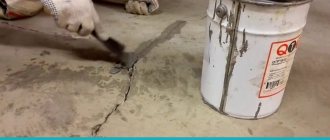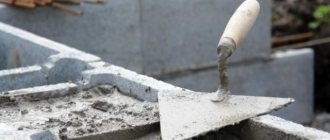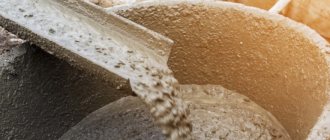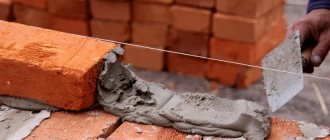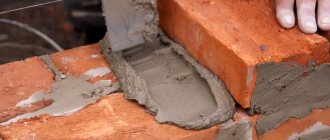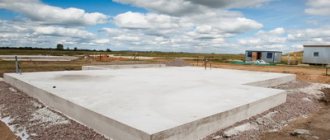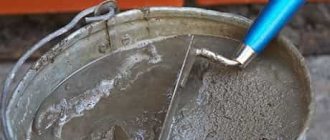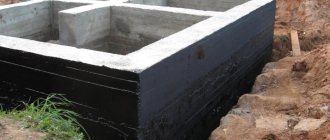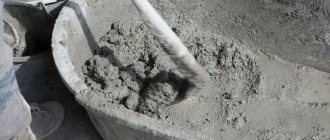The stability and durability of any structure directly depends on the strength and reliability of the foundation - the foundation of the house. Its construction requires special knowledge and the qualifications and experience of the master.
As a rule, the design for the foundation of any building is selected depending on the soil of the land on which it is planned, the material for the walls, climate, conditions and the nature of the structure itself. There are several types of foundations that are used for construction.
Required proportions of mortar for the foundation
Correctly calculated proportions of the foundation mortar are the basis for the reliability of the building. Being the main supporting structure, the foundation must be durable. Strict adherence to the ratio of its constituent components is a prerequisite for preparing the solution. The ultimate strength of the base of the structure can be obtained if concrete is poured into the formwork within one day.
Table of cement composition.
Pouring the foundation.
Scheme for preparing concrete.
Before you start pouring the foundation, you need to prepare everything for this. First, you need to dig a trench of the required perimeter. Then arrange a “pillow” of sand in it and compact it. After this, carry out reinforcement by tying all the reinforcement. At the end, arrange formwork for the foundation and arrange waterproofing. Next you need to move on to filling.
To avoid the appearance of microscopic voids inside the foundation during pouring, you need to compact the concrete mixture from time to time using a vibrator or some other means at hand. Then it needs to be pierced so that excess air comes out, for example, with a reinforcing rod.
The pouring process must be layer-by-layer, i.e. You need to fill one layer at a time, the thickness of which is 15-20 cm, and then the next, etc. For better binding, the previous layer must be doused with water. The foundation should be poured in the warm season. If this is not possible, then the water and concrete mixture must be heated so that the water does not freeze before the cement sets. While the concrete is maturing, it will also have to be heated all the time.
At the end, after complete filling with the solution, the foundation should be covered with film or roofing felt to protect it from sunlight and precipitation. In the first three days, the surface must be moistened every four hours, and then every eight hours. The foundation is completely ready a month after it is poured.
How to prepare concrete for a strip foundation
It is better to count each line (ribbon) of the foundation separately, and then add everything up. The length of the tape is multiplied by the height, then by the width. Let’s say one foundation strip has the following dimensions: length – 10 m, height – 1 m, width – 0.5 m. This turns out to be 5 m 3 of concrete per strip.
If you count each tape along its full length (from corner to corner), it turns out that the volume of each corner is counted twice. This is necessary, since it is better to make more concrete than required. The foundation pit is never perfectly smooth.
It is advisable to pour concrete into the formwork in layers. For example, if the height of the foundation is 1 m, then you can concrete it in 4 layers of 25 cm each. When pouring each layer, it is advisable to compact it with a vibrator or at least tapping it with a hammer/shovel. After pouring each layer, you need to release the air from it by sticking reinforcement every 1-3 m (not very quickly). Also, each layer of concrete must be leveled with a board. For clarity, the height of each layer can be marked in the formwork.
The calculation, preparation and pouring of concrete into the grillage is carried out in the same way.
How to properly dilute cement - mixture proportions
Cement is a popular building material used in the process of performing various works. It produces concrete used in the construction or repair of structures, when creating foundations or other objects. It is cement that is the main component for the formation of concrete mortar. Therefore, you need to know exactly how to properly create this mixture so that it has the desired consistency and homogeneity. So, let's look at how to properly dilute cement.
CONTENT
Creating a base with your own hands
You can make the foundation for a Russian stove with your own hands, following a certain sequence of actions:
- First, they dig a pit, adhering to the size of the foundation for the furnace. The bottom of the pit is leveled and compacted.
- Pour a layer of sand and crushed stone, water it with water and compact it.
- Next, arrange a cushion of broken brick or crushed stone, level it and fill it with liquid cement mortar.
- The next step in building a foundation for the stove with your own hands will be laying solid brick or rubble stone. During the laying process, they control the evenness of the rows and make sure to bandage the seams. After laying the last row, check the horizontalness of the top using a building level. If necessary, level the surface with a layer of cement mortar.
- Ruberoid is laid in two layers on a flat cement surface. This waterproofing material will prevent groundwater from penetrating into the brickwork of the sauna stove.
- Several more rows of bricks should be placed on the roofing felt so that the structure reaches the floor level. In this form, the foundation for the stove is left to dry and gain the necessary strength.
When constructing a strip foundation for a furnace or other type of foundation, it is not recommended to connect it with a foundation erected for walls. Even if the location is very close, you need to leave a gap of several centimeters and fill it with sand or crushed stone.
Basic rules for creating a high-quality solution
The basic rules used in the process of creating a high-quality mixture include:
- it is allowed to mix the components and fill them with water in a metal or plastic container;
- the size of the container depends on the volume of solution that needs to be obtained in the end;
- Initially, the dry components are mixed, namely sand and cement, and they must be sifted through a fine sieve in advance so that they are completely free of any large impurities or inclusions;
- Next, clean water is added to this mixture, and it is desirable that it be cold;
- while adding water, the mixture must be thoroughly mixed to obtain an optimal consistency, similar to sour cream;
- It is quite easy to determine the desired thickness, since the mixture must stay on the spatula, and at the same time it must not flow from it.
The resulting solution has optimal parameters for an hour and a half, so it is necessary to use it for its intended purpose within this time, and if this does not work, then you will have to make a new mixture.
Concrete
The classic base for a furnace is a concrete slab, which is made by pouring cement-crushed stone mortar into a deep pit.
Circuit and device
The general structure of the foundation is the same regardless of the type of furnace and soil; usually it is a solid base in the form of a cube, which is made from a large amount of concrete mortar. The base structure is clearly shown in this diagram:
The diagram shows the base that we calculated above for a stove weighing 1150 kilograms.
Materials and tools
To install a high-quality concrete foundation, a certain list of materials is required:
- Cement;
- Coarse sand;
- Boards for formwork construction;
- Crushed stone;
- Waterproofing, which is ideally served by roofing felt or polyethylene film.
Also, to install a concrete foundation for a brick oven with your own hands, you need the following tools:
- Container for preparing mortar or concrete mixer;
- Bayonet and shovel shovels;
- Measuring tools: tape measure, corner, level;
- For making formwork: hammer, hacksaw, nails;
- To install waterproofing, a construction stapler;
- For laying the base, a manual tamper is used.
Preparation of the solution
The base for the furnace must be strong, so the concrete solution is prepared in the following proportions: 1 part cement, 3 parts sand, 5 parts crushed stone. This consistency can withstand large ovens for a long time.
Manufacturing instructions
- It doesn’t matter what kind of brick or concrete base is installed under the stove, it is initially necessary to dig a foundation pit for it. The depth of the pit depends on several factors: the mass of the stove, the type of soil, and the presence of groundwater. The width and length of the pit must correspond to the dimensions of the heating system and additionally have a certain margin of distance for the formwork. In order not to accidentally make a mistake, it is recommended to first prepare a drawing of the future concrete foundation.
- After this, formwork is installed, the dimensions corresponding to the final values of the dimensions of the structure, according to the drawing and diagram, which should have been prepared in advance. Sometimes formwork is not needed - if the soil is very hard and does not collapse from external influences on it.
- After the formwork is ready, the waterproofing is laid, attached to the formwork using a stapler.
- Pieces of brick or large stones are poured into the resulting hole - this is necessary so that the resulting concrete slab under the stove does not sag and is well adhered to the ground, as shown in the photo below:
- Then the concrete solution is poured so that the base rises 6 centimeters above the floor. When pouring, carefully measure its evenness using a building level and level it to perfection.
- If it is possible to line the ground part of the foundation with brick or rubble concrete, this can be done this way:
Composition of foundation concrete
You can prepare a concrete solution for a foundation support yourself; for this you just need to know what concrete is and what characteristics it has.
The solution itself consists of a combination of binders (cement), filler and various additives that impart characteristic qualities and properties to the entire casting mass. Then the formed solution is diluted in the required proportions with water.
The composition of the foundation mortar has been used in construction for several years now, and every day it is being improved and its quality and strength indicators are increasing.
Each individual component is responsible for the specific quality of the concrete solution. Therefore, the final quality of the material depends on the proportions of its components used. In order for the final performance of the mortar to perfectly match the construction, it is necessary to take into account the construction site and its purpose.
Composition of concrete for foundation proportions in buckets
Important! If the proportionality of the concrete solution is determined by buckets, then it is necessary to take into account the brand of cement. If it changes, then the proportions in creating the solution are replaced.
The main components in concrete:
- Cement binds the fillers together.
- Fillers . These include: gravel, crushed stone, sand, bulk additives.
- Water.
There are several ways to mix a proportional concrete solution. The most common option is concrete mixers, into which the required number of buckets of sand, crushed stone, cement and water are loaded, and then the device thoroughly mixes the materials together.
Forming a solution in buckets is important in several cases:
- For construction work, less than 4 m3 of mortar is required.
- Inability to deliver concrete from the plant due to location problems, for example, the production company is located far away, and the cost of delivering the material is too high.
- The foundation is poured intermittently, for example, when several tiers of the structure are formed.
- There is no access to the installation of automatic mixers and concrete mixers at the site under construction
Proportions of concrete for the foundation in buckets
As a rule, measurements using buckets are used for small amounts of work.
Weight dimensions of components for making concrete mortar:
- cement – 1;
- sand – 3;
- crushed stone (gravel) – 5.
Each component of the concrete solution has a different volumetric weight, for example, the weight of one bucket of sand is 19.5 kg, cement - 15.6 kg, and gravel - 17 kg. Therefore, in practice, a convenient option for the proportions of cement, sand and gravel is 2:5:9. In some situations, gravel is replaced with crushed stone.
If the construction of the structure is carried out with your own hands, then a ready-made sand and gravel mixture (PGM) is used. The ratio of concrete for the foundation to the mixture is approximately 1 bucket of cement to 5 buckets of ASG.
How to build a foundation yourself: a step-by-step guide
- Determine the depth of soil water and soil composition. To do this, you need to dig a hole one meter deep. The absence of water in it means that the soil waters lie deep. If the soil is a mixture of gravel, stone and sand, you can stop at a simple strip base, buried half a meter. If there is water in the hole, the foundation must be deepened to 0.5-1.2 m.
Before constructing the foundation, find out the level of groundwater. Mark the area, remove the fertile layer of soil. Dig a trench of the required depth along the perimeter of the future building, level the bottom with sand.
The hole for the “tape” can be of different depths. Before building the foundation for the house, make formwork from plywood sheets or boards. Then you can start filling. To do this, use a cement mixture with a suitable filler. To prepare it, take cement, crushed stone and coarse sand in a ratio of 1:5:3. The components are mixed and poured with water to obtain a creamy consistency. The thicker the solution, the stronger the foundation will be.
The formwork for the base of the house is made of boards
- Lay the foundation of stones, blocks or bricks using cement mortar. You need to start from a sand cushion. The width is 20 cm thicker than the walls of the house. The foundation is reinforced with metal rods fastened with wire.
- Waterproof the base. At ground level, place two layers of roofing felt in the trench, then continue building the foundation to the desired height. To improve waterproofing, the underground part of the base is coated in several layers with hot bitumen, after which the trench is backfilled. At this stage, you need to level the foundation using a level. If necessary, make inlets for sewerage and water supply.
For a high-quality foundation, it is necessary to waterproof the underground part of the foundation. Lay blocks or bricks in rows above the waterproofing layer. To prevent the accumulation of dampness in the subfloor space, it is necessary to leave ventilation holes in the opposite walls of the base.
After insulation and waterproofing, we lay several basement rows of bricks - After completing the foundation, waterproof it again using roofing felt or other similar material.
You can also watch a video on how to make a foundation for a house. Below we will look at the features of constructing foundations for the most popular types of buildings.
Types of concrete for pouring the base
To prepare a solution for the foundation, sand is suitable, the particle size of which varies from 1.2 to 3.5 mm. Bulk material without foreign impurities is used. A five percent clay and silt content is allowed, but this makes the concrete less durable.
The following experiment will help determine the quality of the composition: pour sand into a container, dilute it with water and shake the resulting solution thoroughly. If the water remains clear or loses a little transparency, it means the raw material is of high quality, and if it becomes very cloudy, it contains impurities. You can also leave the container to stand for a while. If clay sediment eventually appears above the sand, it is better not to use such bulk material for construction.
There should also be no impurities in the crushed stone composition. The particle size is 1-8 cm.
In the construction field, the following types of cement are distinguished:
- Portland cement (the most common option, which is used in the construction of various structures).
- Slag Portland cement (has high moisture resistance and frost resistance, but hardens more slowly).
- Pozzolanic Portland cement (used for the construction of structures under water and underground due to its exceptional moisture-resistant properties; in air conditions it shrinks strongly and loses strength).
- Fast-hardening cement (hardens in about 2 weeks; it is necessary to work with such material without delay, as it sets instantly, so this is not the best option for novice builders).
Thus, the most suitable material for self-filling a monolithic foundation for a house or other structure is Portland cement.
The following grades of cement are distinguished: ... PTs 500, PTs 500 D20, PTs 400 D20, PTs 400, etc. In accordance with the brand, the value of its compressive strength changes, which is determined for a concrete cube with sides of 20 cm and is measured in kg/cm2 .
Is it possible to add broken bricks to the foundation?
Material such as brick has long been used not only for the construction of various buildings, but also as a foundation. This option has become widespread in the construction of private houses with a height of no more than 3 floors.
In addition, when pouring a brick foundation, the following points should be taken into account:
But, even if the soil is slightly mobile, a brick foundation can be laid, but you will first need to pour a reinforced concrete base.
If the groundwater is high, then in this case additional special components are used that are added to the solution to prevent the destruction of the material from moisture.
Only when deciding to use brick for the foundation, it is worth considering that its service life compared to the concrete option is much shorter.
In this case, you may be interested in the question: “Is it possible to add broken bricks to concrete?” This is what will be discussed in this material.
What is a boot and how to use it
Rubble, or, in other words, broken brick, appears as a result of the demolition of various brick structures, for example, houses, outbuildings and other objects. Also, secondary brick raw materials are obtained during the production of bricks directly at factories.
It is inevitable that you will receive broken bricks in the process of laying brickwork.
In what proportions should concrete be made?
In most situations, for frame-type buildings, a columnar version of the foundation is used, which does not require a concrete mixture with increased strength indicators. For this type, M 200 concrete is suitable, which is made from M 500 cement, sand, crushed stone and water.
For one cubic meter of mixture you need:
- 300–350 kg of cement;
- 1100–1200 kg of crushed stone;
- 600–700 kg of sand;
- 150–180 liters of water.
This ratio of materials is formed by their qualities, for example, granite crushed stone has a high level of strength in comparison with dolomite crushed stone or limestone, so it can be used in smaller quantities.
To create a concrete mixture of the required consistency, it is best to use washed crushed stone and only purified river sand, which does not contain various clay impurities.
If you use low quality sand, holes and potholes may form in the base.
When choosing cement, first pay attention to the manufacturer's company. As a rule, the more famous the organization, the less likely it is to purchase a low-quality product.
Water should also be consumed clean, so that it is free of impurities and salts. If construction is carried out in the cold season, then the water, like other components of the concrete solution, should be heated to +600C to give the solution the necessary consistency and strength.
Step-by-step construction instructions
The construction of a pile asbestos-cement foundation is carried out in several stages:
- Carrying out calculations.
- Preparation of the construction site, building materials and tools.
- Well preparation.
- Installation of pipes.
- Preparation of cement mortar.
- Preparing the pile base.
- Backfilling of wells.
- Reinforcement of supports.
- Pouring pipes.
Carrying out calculations
This stage cannot be skipped; errors in foundation calculations can be costly for the owner of the building.
- Depth of wells for piles. The supports must extend to stable ground and end below the freezing depth of the soil.
- Length of pipes. Usually it is 10 cm greater than the depth of the wells, but in areas prone to flooding, the difference is increased by another 20 cm or by the height of flooding, if known.
- Number of supports. Piles are installed in the corners of the building, under the intersections of walls and under areas of increased load (heat-generating devices, plumbing equipment). In addition to anchor piles, additional ones are installed in 1-meter increments.
- Pipe diameter. First, calculate the total weight of the future building, according to tables from SNiP, then divide the resulting figure by the number of supports. If the obtained value is within 800 kg per pile, then pipes with a diameter of 100 mm should be used; if larger, pipes with a diameter of 200-250 mm should be used. Calculating the total weight is only necessary for large buildings and residential buildings. For small architectural forms and commercial buildings, this step can be skipped, choosing to use 100 mm pipes.
- Well diameter. This value is 10-20 cm larger than the calculated pipe diameter.
- Concrete consumption. To obtain this value, you need to calculate the total internal volume of the pipes. It is obtained by the formula for the volume of a cylinder: V=0.785*D2*n*(L+0.2), where V is the volume of the pipe, D is its diameter and L is the length, A n is the total number of pipes. The resulting value is rounded up - this will be the concrete consumption.
Video: how to properly mix cement mortar
Cement can be diluted with different components, and their quantity and purpose depend on the purpose for which the final solution will be used. It is important to use only high-quality and clean materials, and to mix them in the correct sequence. It is recommended to use a concrete mixer or construction mixer for mixing, since manual mixing does not ensure uniform distribution of all components. If you correctly follow all recommendations, you are guaranteed to obtain a high-quality and optimal solution for specific purposes. That's all, we hope this article - “How to properly dilute cement” was useful to you.
Component ratio.
Practice shows that the proportion of the composition includes: 1 hour of cement, 3 hours of sand and 4-5 hours of crushed stone (gravel). As for the water introduced into the composition, its volume depends on the brand of concrete the production of which is planned and is calculated based on the value of 0.25-1 liters per 1 kg of cement. It is worth remembering that the more water, the lower the viscosity of the resulting composition. Therefore, the volume of water is added at the level of 0.75 liters per 1 kg of cement.
Table of proportions of concrete components when using M400 cement (cement, sand, crushed stone).
When choosing mortar components, the rule is that the grade of cement should be 2 times higher than the grade of the resulting concrete. M150 concrete requires M300 cement and higher. However, even if the prescribed proportions are correctly observed, you need to make sure that the finished composition has a suitable consistency. It is easier to do this with a shovel - the solution should drain from it slowly, and the kneading should be done with force. If the concrete is too dense, it is diluted with water until the required consistency is obtained.
It is advisable to choose dry and clean sand. When using wet sand, you should remember the presence of moisture in it - the volume of water poured in in this case is reduced. The size of the gravel should not exceed 2 cm. Cement is purchased immediately before use, this is due to the accumulation of moisture and loss of bonding characteristics.
Making concrete yourself.
Mix the foundation solution in a concrete mixer, steel bath or wooden box. First of all, bulk components are poured - gravel, sand, cement. After thorough mixing, add water without ceasing to stir the mass. Pouring is carried out 2 hours after the mixture is prepared - this time is required for the concrete to infuse.
After pouring the foundation, get rid of the air inside it by using a deep vibrator or other similar device.
Practice shows that pouring work should be carried out during the warm period. The introduction of additives into the solution makes it possible to carry out activities even in cold weather, but you should be prepared for the fact that the work itself will be difficult. In this case, you cannot do without heating the water, otherwise the solution will freeze, and the formation of ice on its surface will increase the volume of concrete and lead to deformation of the foundation from the inside.
Recommendation: Not a long review article, from it you will find out whether a solution is needed for the foundation and what its proportions are. Actually, are you building a chicken coop? What the hell is the solution? Concrete is needed, even for a chicken coop. All buildings need concrete for the foundation and the proportions are concrete, not mortar. However, it’s up to you, you can even build a foundation out of sand. Well, what if your sandy foundation crumbles later, because you don’t have a lot of money!
Materials for the mixture
In order to make concrete for the foundation, you will need:
- water;
- sand;
- cement;
- crushed stone;
- additives (if necessary).
Water for preparing cement mortar should, if possible, not contain chemicals (fuel oil, gasoline, etc.). Ordinary running water is what you need.
The sand should not be silty or clayey. Fatty substances create films that prevent the components from adhering to each other. Ideally, washed sand goes into the solution, the cleaner the better.
Cement is distinguished by its brand. The most common are M300, M400 and M500. The higher the grade of cement, the higher the quality of the resulting solution, that is, such technical characteristics as compressive and fracture strength.
According to the construction goals and the size of the foundation, a specific brand of cement is selected.
In order to prepare a solution for the foundation, you will need water, sand, cement, crushed stone, and, if necessary, various additives.
Crushed stone should not be limestone. You should also not add gravel as a filler for cement mortar. It is better to take crushed stone. Its sharp corners and uneven edges cling to each other and thereby increase the strength of the concrete for the foundation. Cement-sand, as well as mortar based on gravel, expanded clay, and other fillers will be less durable and therefore not used in the manufacture of concrete for foundations.
Additives are needed if you need to make a solution under special conditions. For example, when you need to make a solution in frosty weather, or the finished foundation will be partially or entirely in water and exposed to an aggressive environment. Additives are mixed with water according to the instructions on the package. It is worth remembering that any additives lower the grade of concrete.
Types of bases
The type of foundation and its possible loads are determined at the design stage. At the same time, the weight of the structure and the required strength of the base structure are calculated.
The strength characteristics of the basic structure depend on:
- type of foundation chosen,
- concrete composition,
- presence of reinforcement.
Almost any foundation, except for a pile foundation constructed using metal pipes, is filled with concrete:
| Tape | Available in varying degrees of depth. Can be performed with or without metal reinforcement. It is laid under the load-bearing walls of the building. |
| Monolithic slab | It is poured over an area slightly larger than the size of the building. The most expensive and labor-intensive type of foundation. The strongest foundation. |
| Pillars | Suitable for light buildings. It is poured pointwise in places of high loads: corners of the building, intersections of walls. |
| Piles | Not all types of piles are installed using mortar. The consumption rate is prescribed in the design documentation. |
On a note! Regardless of the composition of the concrete mixture for the foundation specified in the project, the pouring must be done at one time. Otherwise, the strength characteristics of the base will be changed.
Violation of the foundation pouring technology, or incorrect proportions of the solution, can subsequently lead to disastrous results
Basic proportions
When preparing solutions, the working measure is the mass or volume fraction of the binder; the most common and convenient ratios include 1:3:5 (cement, sand, gravel, respectively). The regulated proportions, depending on the required strength of concrete, are:
| Final brand of solution | Mass fraction, kg | ||
| Cement M400 | Sand | Crushed stone or gravel | |
| M100 | 1 | 4,6 | 7 |
| M150 | 3,5 | 5,7 | |
| M200 | 2,8 | 4,8 | |
| M250 | 2,1 | 3,9 | |
| M300 | 1,9 | 3,7 | |
| M350 | 1,2 | 2,7 | |
| M400 | 1,1 | 2,5 | |
The strength of concrete is primarily affected by the ratio of sand and cement, but in addition to strict control over the proportion of dry components, the amount of water introduced is monitored. When using Portland cement, the W/C proportions are:
| Binder grade | Concrete strength grade | ||||
| 150 | 200 | 250 | 300 | 400 | |
| M300 | 0,65 | 0,55 | 0,50 | 0,40 | |
| M400 | 0,75 | 0,63 | 0,56 | 0,50 | 0,40 |
| M500 | 0,85 | 0,71 | 0,64 | 0,60 | 0,46 |
| M600 | 0,95 | 0,75 | 0,68 | 0,63 | 0,50 |
When building a foundation on dry soils, it is allowed to add lime or clay to the cement mortar; these components increase its plasticity. The recommended proportions when using Portland cement M400 are:
| The resulting brand of solution | Share of cement | Lime percentage | Sand fraction |
| M100 | 1 | 0,4 | 4,5 |
| M150 | 0,2 | 3 | |
| M200 | 0,1 | 2,5 |
In private construction, it is inconvenient to separately determine the mass of all poured ingredients; a bucket is usually used as a measuring tool. In this case, all fillers are pre-weighed in a dry state. The W/C ratio largely depends on the moisture content of the sand; experienced developers add no more than 80% of the recommended proportion of water during mixing and then, if necessary (the consistency is not sufficiently plastic), pour it in portions. Fiber, PAD and other plasticizers are added to concrete at the very end along with the liquid; their share usually does not exceed 75 g per 1 m3.
Component Requirements
To prepare cement mortar for pouring the foundation, the following is used:
- Fresh Portland cement, ideally the release date does not exceed 2 months before the start of concreting. The recommended brand is M400 or M500.
- River sand with particle sizes ranging from 1.2-3.5 mm with admixtures of silt or clay not exceeding 5%. It is recommended to check its cleanliness (fill with water and monitor the change in color and sediment), sift, and, if necessary, rinse and dry.
- Pure crushed stone or gravel with fraction sizes from 1 to 8 cm, with flakiness within 20%. When preparing concrete for the foundation, hard rock screenings are used; limestone is not suitable due to its low strength.
- Water: tap water, free of impurities and foreign particles.
- Additives: antifreeze, plasticizing, reinforcing fiber. The introduction of such impurities is carried out in strict compliance with proportions.
It is important to understand the principle: coarse filler is introduced into the solution not only to replace the more expensive binder, it is precisely this that imparts the necessary rigidity. The minimum compressive strength of gravel or granite screenings is 800 kgf/cm2; in its absence, concrete simply will not withstand the weight load. A mixture for a foundation without crushed stone is prepared only when constructing it from individual blocks or slabs, and sometimes for quickly pouring pile supports.
The recommended proportions of cement and sand for masonry mortars are 1:3 or 1:2. The first ratio is considered universal, the second is chosen when constructing foundations on unstable soils. In practice, this means that for one bucket of cement with a grade not lower than M400 (M500 for increased loads), take 2 or 3 sifted quartz sand and no more than 0.8 parts of water. A properly prepared mixture has a consistency similar to toothpaste; to increase workability, 75-100 g of plasticizers (liquid soap or other PADs) are added per 1 m3.
How to make cement mortar for the foundation?
The process begins with the preparation of components and a concrete mixer; the presence of the latter is mandatory when mixing concrete for underground structures. The amount of building materials is calculated in advance according to the volume of the foundation and is purchased with a small margin. It is extremely important to fill the solution on the same day; when preparing the solution yourself, all components are washed and dried in advance. Next, they are poured into buckets into a concrete mixer in the following sequence: part of the water → sand and cement → dry additives and fiber (if necessary) → coarse filler → the remaining liquid in small portions. After adding the new ingredient, the drum is turned on for 2-3 minutes, and no more than 15 minutes later the finished solution is unloaded.
There is a time-tested method for selecting the correct proportions, chosen in the absence of data on the size of crushed stone. In this case, the bucket is filled with coarse filler, shaken several times and completely covered with water. The resulting volume of water corresponds to the required proportion of sand in the solution. After that, sand is poured into the bucket and filled with water again to determine the proportion of cement. But some consider this approach to be complex and outdated; a more correct method is the standard method of recalculating the mass fraction into the volume fraction and pouring the components into a concrete mixer.
In order to independently prepare a cement mortar for pouring the foundation, it is important to select the right components, maintain the necessary proportions of materials and take into account some of the nuances of mixing and pouring.
Its quality and durability depend on how correctly and in what proportions the components for the foundation mortar are selected.
Components for concrete of different grades
| Concrete (grade) | Portland cement | |
| m400 | m500 | |
| 100 | 4,5 (77) | 5,7 (88) |
| 150 | 3,5 (64) | 4,4 (72) |
| 200 | 2,7 (55) | 3,4 (62) |
| 250 | 2,1 (44) | 2,6 (51) |
| 300 | 1,9 (40) | 2,3 (46) |
*The proportion of sand to 1 part of cement is indicated, excluding filler (crushed stone, gravel).
**Proportions are for the foundation only.
***In brackets is the approximate amount of concrete (in “l”) from 1 bucket of cement.
Concrete grades m400 (450), m500 and higher are practically not used in the private sector. The main reason is the high price of m3 and, as a consequence, the unjustified cost of the foundation.
How to make mortar from cement?
Note. When it comes to the proportions of concrete for the foundation, it is understood that there is a filler in the form of crushed stone or gravel and various additives (plasticizers, for example). This is exactly the mass that is poured into the mold (formwork) during the concreting process. Next, we will talk about the specifics of preparing a mixture for a foundation without crushed stone (gravel), since this begins the preparation of not only cement mortar, but also anything else using any other binder.
1. Requirements for components.
- Cement.
All proportions that can be found in various sources are valid only for a “fresh” product. We are not talking about the shelf life (it is indicated on the container), but about the storage time of the binder. Experts believe that every 4-5 months cement loses up to ⅓ of its properties. Therefore, in order to obtain a foundation of design strength, when using “old” products, it is necessary to change the ratio of components (cement/sand) towards increasing the proportion of the former.
The best variety of this binder for foundations is Portland cement. Its characteristics (primarily water resistance, solution hardening time, frost resistance) are higher than those of analogues, for example, Portland slag cement.
- Sand.
In relation to the solution for pouring the foundation, the average size of the granules should not be more than 3.5-4 mm. Wherever it was purchased, it must be sifted before use. The presence of small clay fractions, remnants of vegetation roots and similar inclusions will negatively affect the quality of the artificial foundation stone. Before preparation, the sand should be dried, otherwise you can make a mistake in the ratio of shares.
- Water.
It is added to the mixture prepared for concreting (sand + cement + crushed stone) in portions, in buckets.
This is not directly related to the topic of the article, but it should be noted. You can increase or decrease the grade of concrete (within certain limits) by changing not only the sand-cement ratio, but also the number of buckets of water. In this case, the characteristics of crushed stone (grain sizes and flakiness) are taken into account.
The water taken must be clean, and not only in terms of mechanical contamination. For cement-based mortar, its chemical composition is also important. This means that it is better not from the water supply, but from their wells (wells).
2. Cooking procedure.
After loading the main components (sand + cement) into the container in the required proportion, the entire mass is well mixed. A sign of readiness is a uniform color of the entire structure. If coarse crushed stone is used as a filler for concreting, then the solution must be prepared in a concrete mixer. It is impossible to make a high-quality knead of such a mass by hand.
Depending on the loaded volume, 1-2 buckets of water are poured. It begins to be absorbed into the mixture and, with constant stirring, is gradually added to the container so that the solution reaches the desired consistency.
Some sources provide recommended ratios of all components and water. Once again, it is worth emphasizing the reader’s attention - no matter how much it is taken, it should only be poured in portions, in buckets.
